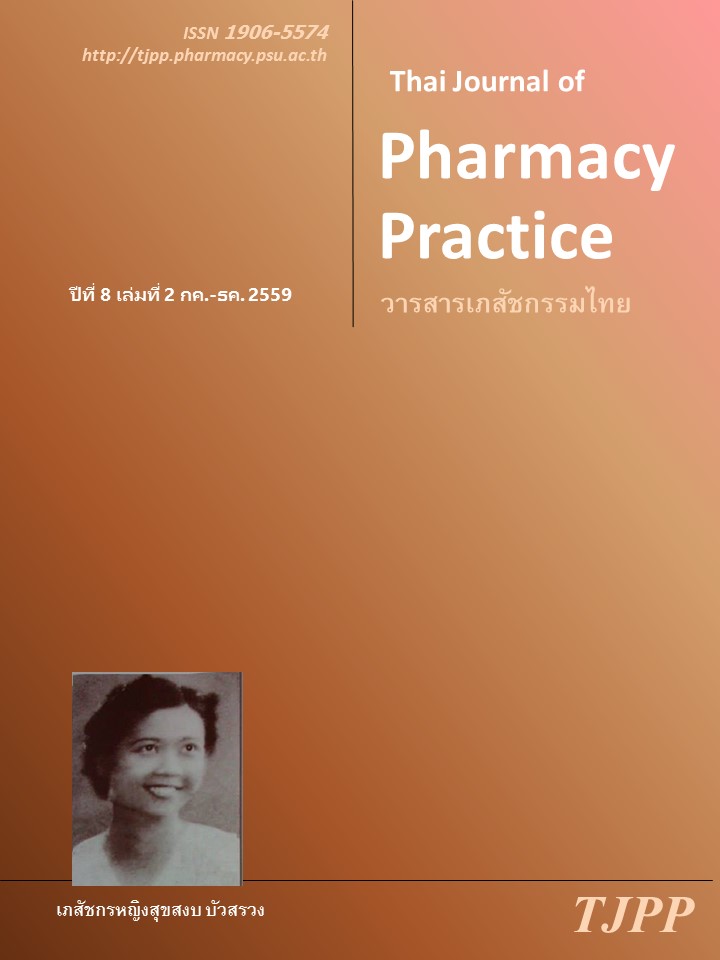การสร้างศักยภาพของชุมชนในการจัดการปัญหายาและ ผลิตภัณฑ์สุขภาพที่ไม่เหมาะสม: กรณีอำเภอโนนคูณ จังหวัดศรีสะเกษ
Main Article Content
บทคัดย่อ
วัตถุประสงค์: เพื่อศึกษาแนวทางการพัฒนาศักยภาพของประชาชนในการจัดการปัญหายาและผลิตภัณฑ์สุขภาพที่ไม่เหมาะสมในชุมชนและปัจจัยความสำเร็จในการจัดการปัญหาของเครือข่ายคุ้มครองผู้บริโภคด้านสาธารณสุขอำเภอโนนคูณ จังหวัดศรีสะเกษ วิธีการวิจัย: การศึกษานี้เป็นการวิจัยเชิงคุณภาพโดยการถอดบทเรียนและวิเคราะห์เนื้อหาจากข้อมูลที่รวบรวมได้จากการวิจัยเอกสารและการสัมภาษณ์เชิงลึกในแกนนำเครือข่ายคุ้มครองผู้บริโภคระดับจังหวัด 2 คน ระดับอำเภอ 5 คนและระดับตำบล 9 คน ผลการวิจัย: ปี 2551 เครือข่ายฯสำรวจข้อมูลการจำหน่ายยาและผลิตภัณฑ์สุขภาพในร้านชำครอบคลุมทั้งอำเภอ เพื่อประเมินปัญหาและนำผลมาเชื่อมกับข้อมูลของผู้ได้รับผลกระทบจากการใช้ยาและผลิตภัณฑ์สุขภาพ ซึ่งพบว่า ร้อยละ 18 ของผู้ได้รับผลกระทบจากการใช้ยาเกิดอาการไม่พึงประสงค์จากการใช้ยาในชุมชน เครือข่ายใช้ข้อมูลนี้ในการขับเคลื่อนงานทั้งระดับผู้บริหารและผู้ปฏิบัติงานโดยเริ่มจากการจัดตั้งต้นแบบร้านชำปลอดยาอันตรายในตำบลโพธิ์ที่มีทีมงานเข้มแข็ง จากนั้นขยายเครือข่ายไปทั้งอำเภอผ่านการประชาคมพร้อมมีการตั้งกติกาชุมชน ต่อมาในปี 2554 เครือข่ายชุมชนเข้าร่วมจัดทำแผนงานโครงการด้านสุขภาพของอำเภอทำให้มีการบูรณาการงานคุ้มครองผู้บริโภคด้านสาธารณสุขกับงานของชุมชน การพัฒนาศักยภาพของชุมชนดำเนินการผ่านกิจกรรมแลกเปลี่ยนเรียนรู้ และการออกตรวจปฏิบัติการจริงในพื้นที่ ในปี 2556 เครือข่ายโนนคูณเข้าร่วมเป็นศูนย์ข้อมูลชุมชนเชื่อมต่องานกับศูนย์วิทยาศาสตร์การแพทย์อุบลราชธานีและศูนย์วิชาการเฝ้าระวังและพัฒนาระบบยา โดยมุ่งแก้ไขปัญหาเชิงระบบ ปัจจัยความสำเร็จได้แก่ การเลือกแกนนำที่มีศักยภาพ สภาพแวดล้อมและเครื่องมือที่เอื้อต่อการทำงาน การจัดทำแผนงานแบบต่อยอด การกระตุ้นทีมงานอย่างต่อเนื่องที่เน้นการประสานงานแบบแนวราบ และการยกย่องเชิดชูบุคคลที่เป็นต้นแบบ ปัญหาอุปสรรค คือ ความเชื่อและค่านิยมในการใช้ยา สื่อและช่องทางการกระจายผลิตภัณฑ์สุขภาพที่เข้าถึงผู้บริโภคโดยตรง สรุป: ผู้เกี่ยวข้องควรบูรณาการการพัฒนาศักยภาพประชาชนพร้อมกันทั้งระดับต้นน้ำ (หน่วยงานราชการที่อยู่ในส่วนกลาง) กลางน้ำ (หน่วยงานราชการที่อยู่ในส่วนจังหวัด) ปลายน้ำ (อำเภอ/ชุมชน) เพื่อให้เกิดการคุ้มครองผู้บริโภคด้านสุขภาพที่มีประสิทธิภาพ
Article Details
ผลการวิจัยและความคิดเห็นที่ปรากฏในบทความถือเป็นความคิดเห็นและอยู่ในความรับผิดชอบของผู้นิพนธ์ มิใช่ความเห็นหรือความรับผิดชอบของกองบรรณาธิการ หรือคณะเภสัชศาสตร์ มหาวิทยาลัยสงขลานครินทร์ ทั้งนี้ไม่รวมความผิดพลาดอันเกิดจากการพิมพ์ บทความที่ได้รับการเผยแพร่โดยวารสารเภสัชกรรมไทยถือเป็นสิทธิ์ของวารสารฯ
เอกสารอ้างอิง
2. Booddawong B, Kiatying-Angsulee N, Wanleepong K, Boonmanus L, Kadsomboon O, Dokbua J, Pratomnam J, Booncherd C, Plengchai S, Thamasorn SP. Pentongdee K. Sources and distribution of unlawful medicines in 8 provinces of Thailand: to inform the public policy change. Isan Journal of Pharmaceutical Sciences. 2016; 11 (Supplement): 260-8.
3. Rujirayunyong T. Situation of illegal advertising of health products among local radios in Lopburi in the era of the National Council for Peace and Order (NCPO). Thai Journal of Pharmacy Practice 2015; 7: 189-99
4. Surin N Surveillance of illegal advertisings of health products among community radios in Muangpan subdistrict, Pan district in Lumpang. In: The College of Pharmaceutical and Health Consumer Protection (CPHCP) of Thailand and Health Consumer Protection Program, editors. Proceedings of the conference for presenting academic work in the training program for board certificates in pharmaceutical and health consumer protection in the second semester; 2015 May 27- 29; Bangkok, Thailand: CPHCP;
2015. p 45-6.
5. Wiriyanutai P. Situation of advertisings of health products among community radios in Ngao district in Lumpang. In: The College of Pharmaceutical and Health Consumer Protection (CPHCP) of Thailand and Health Consumer Protection Program, editors. Proceedings of the conference for presenting academic work in the training program for board certificates in pharmaceutical and health consumer protection in the second semester; 2015 May 27-29; Bangkok, Thailand: CPHCP; 2015. p 54-5. 19. Foundation for Consumers. Reveal unlawful advertising in the era of NCPO [online]. 2014 [cited 2015 Jan 8]. Available from: http://www.con s
6. Chuengsatiansup K, Sri-Ngernyuang L, Paonil W. Drug and community: social and cultural dimension. Nonthaburi: Society and Health Institute, Ministry of Public Health; 2007.
7. Chanthapasa K. Qualitative tools in quality pharmacy service management. Patient centered point of view in pharmaceutical service; 2008 Aug 18-22; Khonkan University.
8. Tomacha N. Problems on drugs in communities and solution: data from 13 provinces confirming the risk from inappropriate drugs available in communities. Yawipak 2013; 5: 10-2.
9. Drug Bureau, Food and Drug Administration. Synergy: eradication of illegal advertisings, empowering consumers to become media literate [online]. 2014 [cited Dec 1, 2014]. Available from promoterdu.com/DownloadFile/FDADoc0006.pdf
10. National Committee on Drug SystemDevelopment National drug policy B.E. 2554 and strategies for drug system development B.E. 2555-2559.
11. Leadership for Educational Change (LEC). Learn- ing processes based on Prawet Wasi’s concepts [online]. 2015 [cited Jan 28, 2016]. Available from: http://www.lecleader.com/lec/?page_id=73
12. Yokanit P, Sungrugsa N. Lesson learned from learning community health care of Nongsarai subdistrict, Phanomthuan district, Khanchanaburi. Silpakorn Educational Research Journal. 2010; 2: 132-40
13. Topinjai P, Akaranithi A. The potential develop- ment of community leaders in community manage ment in the perception of the citizens in Chiang Rai Municipality [online]. 2012 [cited Jan 24, 2016]. Available from: www.mfu.ac.th/school/liberalarts_new/pdf-jornal/2555_3/2555_8.pdf
14. Booddawong B. Summary report on the activities of the Nonkhun Conumer Protection Network during 2008-2015. In: Anon, editor. Proceeding of the 8th annual conference of Nonkun Consumer Protection Network; 2015 Aug 14; Sisaket, Thailand. p 6.
15. Booddawong B. Active surveillance project in chronic disease in Nonkhun district. In: Anon, editor. Proceeding of pharmacy conference; 2015 Sep 7-8; Sisaket, Thailand, p 13.


